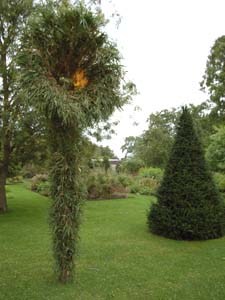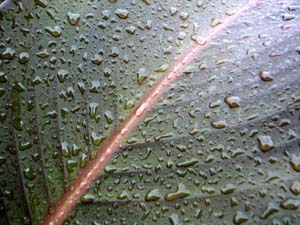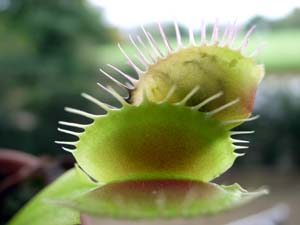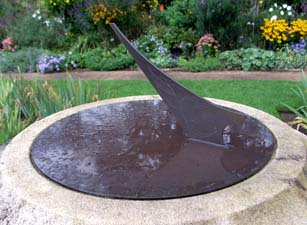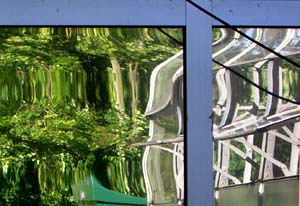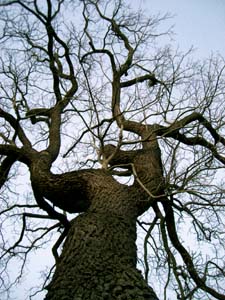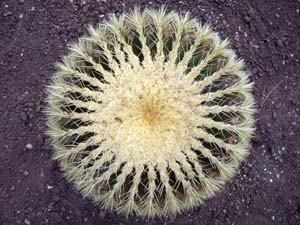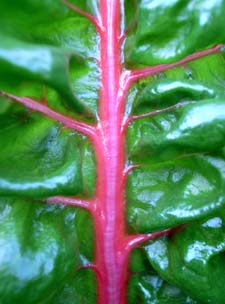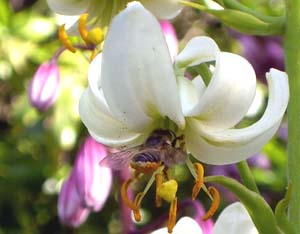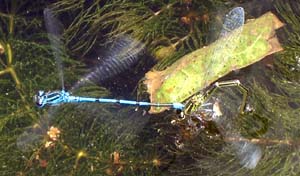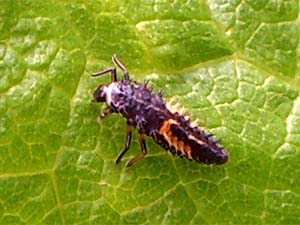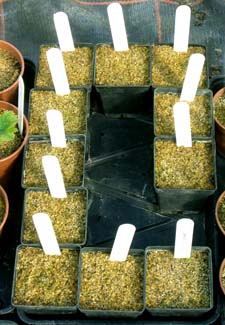take-down
Today is take-down day. It seems a shame to be leaving the Botanic Garden after spending so much time here over the summer. It’s always nice to work outside and, of course, fun to be working alongside a group of artists. Still, I bet the gardeners will be glad to get the greenhouse back (as well as the rest of the garden)!
Last night the weather was better and the audience figures were up to what they were on Thursday. The bats were out all evening and so I was able to simply ‘press go’ and run the piece for the whole event, giving me time to do some impromptu performances around the garden at different times with my CrackleBox and portable Theremin, and finishing off with a nice trio with my trombone with Tim Hill and Max Eastley.
Although last night’s Magic Hour was a very special event, funnily enough, I think my favourite evening was the Friday, after it had finished raining. With less people there, the garden had the wonder of an unexplored land about it, providing a more intimate experience. And, as for the bats, whereas for the other evenings the different species seemed to be following their normal routine of feeding at different times of the evening, it was like they all came out at once, providing a quite special spectacle. It was interesting to observe how inclement weather can actually add to the evening’s experiences in a positive way.
I am grateful to Oxford Contemporary Music and the Botanical Garden for the opportunity to try out my Echolocation sound installation idea, and I have been pleased by the results and excited about its potential. In the programme, I called this piece Echo 1. Now I must look out for other opportunities for the creation of Echo 2, and so on.
END OF BLOG
truly magical
Well, that weather forecast wasn’t correct! The rain began at 7pm, but people still came, though in smaller numbers. When the weather did clear (unfortunately with most of our audience) the place was truly magical as the few people who were left had the garden and its strange sounds and illuminations all to themselves.
Most of the school students that I had been working with on the Predator piece also came tonight and seemed to spend most of the evening enjoying their music and ‘jumping’ to the loud bits. Their screams emanating from the secluded Spring Walk pathway was a rather humourous addition to the sounds in the garden.
The bat activity over the river was pretty minimal during the first part of the evening, I guess as a result of the rain, and so I also fed in a recording of their visit on another evening earlier this week. Eventually, though, the rain did stop, by about 9pm, and then the bats came out in force and put on quite an amazing display, darting in and out of the shafts of light that we have installed along the river.
first night
Well, our first night went really well. About 500 people came and we apparently had some very good feedback about the various pieces. I haven’t seen this yet, but when I do, I will post some of it on this blog. The weather too was as good as could be expected – a still night with no rain. Not so good perhaps for some of the aeolian harp sculptures elsewhere in the garden, but excellent for the bats!
I was really happy with how my bat piece sounded. I spent the first half of the evening in the vicinity of the installation talking with people about how I created the work, and receiving many nice comments, especially from those who realised that they were witnessing a live event, in the sense that the music was being triggered by the bats themselves and was not simply a prerecorded composition. Now, this morning I have a meeting with some of the ‘Friends of the Botanic Garden’ to talk about my work and how it connects with the garden, and then I have a bit more fine-tuning that I still want to do.
There has been a meteorlogical weather warning for Oxford today with apparently high winds and 50mm of rainfall expected today (60.9mm is the normal Sepetember average!) but the good news is that this is all meant to happen this afternoon with a return to quieter conditions by 7pm, which is when our performance is due to begin!
getting there
Last night we had our run-through. It was a bit of a race to get everything finished in time, but we just about made it.
We have a sort of timetable for each evening, with different sounding events occurring at roughly fifteen minute intervals, so it was good to see how that timing felt and to check on the consensus regarding other details, such as sound overspill, and so on.
My bat piece, of course, remains silent until the bats arrive at the Botanic Garden, and then it springs to life. Last night we had our first bat at eight o’clock, and by 8.30pm the piece was very active with lots of sounds.
Based on this experience, I would still like to do some fine tuning on the various sounds within the bat piece, to try and improve on the musical clarity in order to give listeners a deeper listening experience and also to perhaps make the sounds a little more ‘insect’-like – to make a connection with why the bats are there in the first place. So, again, a lot to do before the doors open at 7pm tonight for the first performance.
illumination
For my bat piece I am also making use of some spotlights that shine across the river alongs the flightpaths of the various bat species. For the Daubentons, the lights skim the surface of the water, whilst for the pipistrelles and serotines it is the are just below the the overhanging branches of the trees that are illuminated. These lights do not affect the whole river, but instead provide just enough visibility for viewers to pick out the bats as they listen to the resulting music.
Another effect that the lights have is that they appear to attract insects, which of course is what the bats are there to feed upon, and, in turn, they probably help to increase the concentration of bats providing more data for the sound installation. I had the idea for this after noticing that (at home) bats were often in close proximity to streetlamps – probably because they attracted the larger moths. Usefully therefore, my lights along the Botanic Garden river bank also help link my sound installation to the Botanic Garden location and to the flights of the bats, and thus help to ground the piece, or at least one’s experience of it.
weather
The weather in Oxford has been pretty blustery, with bouts of wind and the occasional heavy shower. Actually, today’s not too bad, but we had a lot of weather yesterday.
The changing conditions are ideal for testing the durability of each installation’s set-up outside. I was concerned, for example, if whether the weatherproof housing for my bat detectors would be effective in a strong wind. Well, we’ve had the weather to prove that not only is this the case but that the bat detectors can survive a lot of rainwater! (I left them out to record overnight last night, and when I arrived this morning I realised there had been quite a downpour).
This is all good stuff as the time to test everything is now. Much better this way than perfect weather on the run-up to the event, and then posed with with a testing performance environment.
final week
For this final week I am resident at the Botanical Garden, setting up my various sound installations. In the end, I will have seven pieces: 4 dna compositions (previously created for the Hannah Peschar Sculpture Garden), an insect piece (created last summer for La Cité des Insectes), my new bat installation, and also the Predator soundscape that I have composed with St Barnabas Primary School – so, a lot to be getting on with as each requires setting up in their own particular way.
I have been allowed to set up all my equipment in a Temperate Zone Cactus Greenhouse, next to where my bat installation will be and full of plants I mustn’t touch, and with the windows open so that it is always cool – I even have cooler fans! What a pity it’s not warm outside!! As well as the cactuses I seem to be sharing my accommodation with a rather beautiful spider, which sits to my left, waiting for its next meal.
There is a sense of excitement in the air at the Garden now as all the artists involved in Magic Hour are also on site, preparing for the public performances on Thursday, Friday and Saturday nights.
getting physical
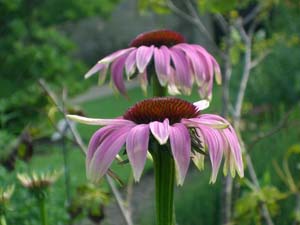
This week I am mostly managing all the physical elements of the installation, such as the cabling and the waterproof housing for the bat detectors. Today, for example, I have 200 or so metres of audio cable to prepare, in order to connect all my pieces of equipment together.
My Echolocation is just about completed, in the sense that there’s not actually that much more that I can do to it until I go the Botanic Garden next week to fine tune it to the evening bat behaviour.
So, it’s out with the soldering iron, the screwdriver, an assortment of plugs and adaptors and cable galore…. My wish is to do absolutely everything that I can do in preparation before my visit, so that when I arrive I can concentrate on the finer detail.
informative music
Ideally, I would like my Echolocation sound installation to not only be musically interesting, but also ‘readable’ in terms of being able to know what the bats are doing, simply by listening. This is actually quite a challenge!
In order to achieve this I will have to have some sort of correlation between the bat detectors picking up the sounds and the sounds used in the composition itself. I am thinking that, for example, I might be able to achieve this through careful use of spatialisation (to refer to the locations of the actual bat detectors) as well as through the use of various threshold detectors (to respond to the variance in speed and volume of the different bat species’ calls).
dna
As well as my Predator and Echolocation sound installations, I am also exhibiting some pieces that have previously been created for the Hannah Peschar Sculpture Garden, in Surrey. These compositions take as their starting point the dna and amino acid sequences of plants in that garden, and the two that I am going to use for Magic Hour are derived from the genetic data of the gunnera and bamboo plants.
The Gunnera composition takes its inspiration from the plant’s chloroplast gene (which converts sunlight into energy for growth). Referencing the plant’s origin (the cloud forests of the Andes) the music makes use of a panpipe sound to play amino acid sequences connected with the leaves’ photosynthesis whilst being accompanied by a faster moving dan sequence highlighting the plants prickly surface.
The Bamboo composition is based on genetic data for the shape of the plant’s leaves (the Liguleless3 gene). Using sounds created to sound like bamboo wood pieces hitting against each other, the music gives the illusion of a giant bamboo wind chime casually playing the plant’s dana, as if it was being blown by a gentle breeze. (Interestingly, perhaps, no amino acid sequences were used in this particular composition as according to the genetic databases that I was using, scientists hadn’t yet published this aspect of the plant. Thus, in a way, the composition also reflects the advances of science at this time).
coming together
Today all the artists and gardeners met with the OCM team to give everyone an update on how each and everyone’s pieces were coming along. We walked through the garden, pausing at various stages whilst the relevant art piece (to be) was explained and discussed. It was good to get an overview of what eventually will be happening, especially as often on these occasions one can be so focused that it is difficult to see one’s work in its wider context.
It was a good day, well spent, with a lot of practical matters discussed and dealt with. It was also good to feel the group coming together and bonding better as a team.
bat music
I have now collected almost all the equipment I will need for my Echolocation sound installation, and am now trying to work out how to put it all together! In the meantime I have been working with recordings that I have previously made of the bats at different points along the River Cherwell, which runs alongside the Botanic Garden.
I am creating this piece using Symbolic Sound’s Kyma Sound Design Language, which allows me to create a series of virtual instruments that the bats will ‘play’ as they fly past and emit their ultrasonic calls. Although I am working with recordings of bats from the Botanic Garden that I made only a few weeks ago, it is still difficult to predict exactly how the piece will sound at the Magic Hour event. One of the reasons for this is that, at this stage, I have no idea as to what the bat activity will be like by the time we get to September, although I am imagining there will be more of them as I am assuming that their young will also be out foraging by then. Fortunately, my Kyma system is powerful enough for me to be able to keep the piece ‘live’, meaning that it should be easy enough to make adjustments to all the different parameters even on the performance nights themselves. That’s the plan, anyway….
echolocation
For my own piece, my intention is to create a sound installation that takes its inspiration from the ultrasonic biosonar calls of the bats that visit the garden in the evening. My plan is to position a series of bat detectors along the River Cherwell, which runs alongside the botanic garden, and then feed the output of these into my Kyma system in order to manipulate the sounds and turn them into something musical.
I ordered my bat detectors today from Magenta Electronics who were not only enthusiastic about my idea but also keen to support the project, so that’s good news!
evening visitors
Whilst I’m in Oxford, I am spending my evenings in the Botanical Garden to make more recordings of the bats, and as such think that I am beginning to understand their behaviour a little more – not that this will necessarily be consistent throughout the season, but at least I have something to build on.
They appear to come out around 15 minutes after sunset, and in the area just above the Spring Walk but over the River Cherwell – one or two first of all, then three or four, but probably no more than about eight at peak. These bats fly mostly between three and five metres above the water, swooping to catch the insects.
Then, as the evening goes on, there is more bat activity further down the river towards the lower end of the Spring Walk and the greenhouses. The bats that first appear here skim along the surface of the water – two or three at first, and then eventually joined by the swooping bats as mentioned above.
Within about three-quarters of an hour this first rush of bat activity appears to die down and then the bat visits become more occasional, and also involving different species. Over the next weeks or so I will have a listen to my recordings and see if I can use these to identify what’s visiting, and when.
building
Worked with the St Barnabas School orchestra today. I played them examples of how I had been working with the recordings of their predator music that I had made on my last visit. They liked these a lot and were very excited to hear both how successful their composition ideas had been as well as how I had worked with their music. Using these recordings as a starting point we then worked on a series of other musical ideas for me to work with and build on the work done so far over their school holidays.
colours
I’m back at the garden again for the next few days, working again with students from St Barnabas’ Primary School.
We noticed today how different insects seem to favour certain coloured plants – for example, the bumble bees were mostly on purple flowering plants. On speaking with the head gardener about this I learnt that indeed this was the case. Different insects are attracted to particular colours, smells, pattern markings as well as flower shapes: beetles seem not to have very discriminating colour vision but are more attracted by odour; flies are attracted to yellow, pink or white colours with sweet fragrances; beeflies and hoverflies pollinate blue to purple flowers; butterflies favour blue-purple, deep pink and yellow flowers with a sweet and pleasant smell; moths, being mostly active at dusk, favour white or pale sweet smelling flowers that are easily locatable in dim light; and finally, bees are red-green colour blind but are attracted to yellow, blue purple and ultraviolet flower colourings.
A photographer came to take some photographs for a newspaper today. Pointing at some blue flowers, he commented that their colour was “unreal”. I assured him that was not the case.
bioelectric
Made an appearance at a Botanic Garden picnic event today. These are events where the general public comes to the garden to see what’s growing, to eat food and to witness various art performances and to take part in workshops. I was invited to show some of my recent investigations into the bioelectrical sonification of plants.
Using some custom-made equipment, I spent the afternoon wiring up some of the garden’s plants (and the occasional fruit from somebody’s lunch) to subject them to a small electric potential, allowing me to use the small changes in voltage to control different aspects of an audio signal.
In this way people were able to hear not only how different each ones sounded but also how sensitive the plants were to their surroundings. It was a real surprise for them to listen to the plants ‘ obvious reaction to being touched as well as simply being near to someone, or to being blown about in the wind.
nature watching
Over the last two evenings I have also been spending time in the Botanic Garden observing the bats that visit of an evening in search of food. Wednesday evening was a lovely summer’s evening and predictably there was a lot of bat activity as they fed along and above the River Cherwell. One of the best observation areas was just below The Spring Walk as the absence in vegetation made it easier to see the bats against the night. This is also quite a handy area as it’s next to one of the temperate greenhouses that not only has electricity but also a humidity that is equipment friendly.
On the Thursday night the weather was foul, and the river became a sort of wind (and rain) tunnel, so not very conducive for the bats feeding. There were, however, a few bats feeding below the Alnus Glutinosa tree, which is just above The Spring Walk. Here they flew round and around the tree just below its canopy again and again, feeding off the insects just below the branches.
During the afternoons I have also tried recording the insects in the garden, but have not had so much success, mainly due to the excessive traffic noise that filers through from Oxford’s busy roads. Even when using a parabolic microphone, I found the rumble too prohibitive. I’ll have to think again about this.
devising
Worked with the school students again today. Starting with their written observations from yesterday’s visit to the Botanic Garden, the pupils devised short musical ideas which I then recorded. It turns out that they have all been learning violins and cellos through their involvement in another project, and so we predominately worked with that instrumentation.
The plan is that I will use snippets of their music, manipulating and processing their sounds and begin to create the installation. As I do, I shall keep the students up to date with my process so that they can offer comments and recommendations, and in this way be a part of the creative process.
When completed, the composition will be heard in an area of the Garden known as The Spring Walk. This is a winding path by the river with low shrubbery on either side. Our idea is that the sounds will come ‘unexpectantly’ from different sources along the path and startle unsuspecting visitors.
observing
Today I worked with pupils from St Barnabas Primary School, investigating the Botanic Garden for insect activity. We spent a fine afternoon exploring the garden and taking note of everything creepy crawly -describing the insects, their movements and any audible sounds. Our plan is to use these observations as a starting point for music making, which we will do back at the school tomorrow.
In the evening I intend to revisit the garden to observe what bat activity there might be as I am also interested in creating an installation based on their biosonar calls.
biocontrol
The Botanic Garden uses a system of biocontrol whereby it introduces insects as natural predators to help keep down unwanted pests and disease. I have been thinking that it might be fun to introduce a form of audio bio-control for the public performances with the introduction of insect sounds into the garden as darkness sets in.
My intention is to work with recordings of the insects that naturally visit the garden as well as those that are brought in specially, and create miniature pieces that will sound from hidden locations around the grounds.
beginnings
Visited the Oxford Botanical Garden yesterday to meet the other artists involved in the project as well as staff who work there. After discussing the project, we were shown round the gardens in the winter sunshine learning about the garden’s history and the stories behind some of the plants.
The Garden is the oldest of its kind in the UK and is home to around seven thousand different types of plant, making it the most compact yet diverse collection of plants in the world. Plants are grown to support the garden’s educational programme, for research projects, and as part of plant conservation.
The artists involved in this project have been invited to create work in response to the garden and its plants. As the result is to be shown over three evenings next September, the theme of twilight, or dusk, is also to be drawn on.
